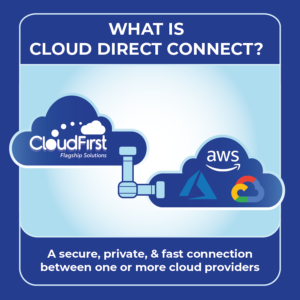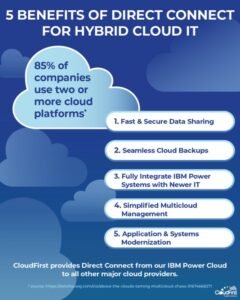If you’ve ever thought about moving your IBM Power Systems to the cloud, you’ve come to the realization that most cloud providers like Azure and AWS don’t support Power. Even if you did find a way to migrate those servers to the cloud, you need to make sure they play nice with the rest of your IT.
Without a way to connect cloud-based Power Systems with your other clouds, your applications won’t be able to get the data they need and you won’t be able to keep your databases updated. Your IT will be fragmented. That’s why you need Direct Connect.
The Wall Street Journal recognizes this frustration, saying that “as much as 85% of businesses are using two or more cloud platforms, and 25% are using at least five.” While this can be a boon for some businesses, it’s only if they’re doing so by choice—not because they can’t find any other options.
If you’re a dedicated IBM Power Systems user, you’re unfortunately used to finding workarounds because none are provided for you. There’s no single streamlined solution to facilitate everything you need in one location.
All of that changes with IBM Cloud Direct Connect. This secure connection enables you to operate across multiple clouds as if you’re using only one. It’s a straightforward solution to the problem that plagues IBM Cloud users. There’s finally a way to access, host, and extract everything you need without hassle and without compromising on using IBM i or AIX for your database servers.
But how significant an impact does IBM Cloud Direct Connect have on your business? And what makes it so appealing to IBM users? Let’s get more specific about the benefits of establishing this connection and the ways it can revolutionize your IT infrastructure.
What is Direct Connect?

Direct Connect is a private, secure way to link one cloud hosting service to another. It’s basically a giant pipe connecting multiple clouds together.
The result is a fully integrated IT system with realtime data sharing across an IBM hybrid cloud mesh. The “direct” part of the connection means there’s no risk of the information being shared with the wrong parties; everything is always completely secure.
This technology is a major win for IBM users who feel stuck between two less-than-optimal prospects: overhauling their IT or constantly operating out of two locations. It also means you can run any applications you have on one cloud seamlessly without manually transferring data between the two—everything is already working together. Thanks to Direct Connect, you can use IBM Power on Azure or AWS.
Other cloud hosting platforms provide similar Direct Connect services, but they don’t have integrated solutions for IBM users. IBM Cloud Direct Connect fills that niche, meaning companies that don’t want to give up the IBM Power databases they’ve had for years or even decades finally have room to breathe.
Why is Direct Connect such a good solution for creating an IBM Power hybrid cloud environment?
Direct Connect is instrumental for creating an IBM hybrid cloud computing environment because without it your environment is hybrid in name alone.
The most obvious reason a Direct Connect service works so well is how secure it is in transmitting information. The security risks that come along with operating across multiple clouds can be concerning for any company.
The private connection ensures that none of your information or applications can be accessed by anyone or anything outside the secure connection. The alternative, the virtual private network (VPN), isn’t nearly as secure; there’s nothing virtual about Direct Connect because it’s completely private.
Another benefit is the capability to build a custom infrastructure without rebuilding from the ground up. Investing in a new IT system is an undertaking that most businesses would rather avoid; the expense alone is enough to make a business owner seek any alternative.
Operating with cloud hosting is already saving businesses a staggering amount of money. The Atlantic states that organizations with large IT infrastructures, like local governments, reduce their computing costs significantly when they adopt cloud services. For example, the article quotes the City of Orlando as having saved up to 60% on IT costs.
The Atlantic’s reporting even found that smaller companies benefit from cloud hosting, despite the upfront cost often giving them pause. Moving to a system like an IBM cloud environment can in fact reduce their overall support costs. And furthermore, any money saved in the short term by not investing won’t go far if you have to revisit your IT infrastructure.
Direct Connect is the perfect alternative; it’s cost-effective because it doesn’t require any gutting of your current IT to operate. CloudFirst simply connects our IBM Power Systems cloud to your AWS, Azure, or other cloud, and you’re ready to start using your integrated cloud hosting environment. For those with multiple cloud hosting services, like companies that operate out of several clouds, this streamlines your processes even further by creating a hub where you can access all of your data.
Finally, consistent performance is vital for anyone operating with a multi-cloud architecture. Streamlined operations become significantly more challenging when the two clouds aren’t compatible. IBM Cloud Direct Connect alleviates this incompatibility. This means your company can transfer sensitive information—and large amounts of it—without worrying about bottlenecks.
Considerations for getting started with IBM Cloud Direct Connect

Businesses getting familiar with IBM Cloud Direct Connect can get the most out of their service by understanding its capabilities. It’s a system that enables you to work as you need to without the constraints of using multiple cloud hosting services. But here’s what you should consider in order to get more value from your new direct connection.
Establishing backups
IBM Cloud Direct Connect is fantastic if you’re establishing additional backups as part of your business continuity plan (BCP). This is an excellent way to use direct connect services as a means to house and access backups whenever you need them while still operating IBM i or IBM AIX on AWS or Azure.
We recommend having another backup for your information as you integrate it into the cloud, whether you operate with a hybrid model or not. Accounting for all scenarios is one of the primary considerations when creating your BCP, and using IBM Cloud Direct Connect makes many of the concerns you might uncover in your brainstorming obsolete.
Flexibility for future-proofing
Companies that stay flexible will always have options when it might seem like there are none. Having a multi-cloud setup gives you a versatile way to handle your data management, no matter what the next few years throw your way. This transition period presents an excellent opportunity to start migrating information between cloud instances in a way that suits your business’s current needs.
Cloud management and application access
Remember that with IBM and Direct Connect, you’ll be able to operate applications from any of your clouds without worrying that they won’t work correctly. Operating applications from a single location should allow you to use your resources as you see fit, sending application data between cloud instances or even from one cloud to a different IT architecture.
Forbes also recommends using hybrid cloud environments as a way to consolidate your IT infrastructure. In an article about how to control IT costs with hybrid cloud services, they mention how consolidating reduces the need for servers and other hardware to run essential applications. Not only that, but having multiple clouds that manage your data makes automating more repetitive tasks like scaling and creating backups simple and cost-effective.
Creating seamless connections for optimized workflow

While support for IBM Power Systems is becoming less commonplace, that doesn’t mean you have to tear everything down and start over. It also doesn’t mean you have to sacrifice the advantages of cloud computing. IBM Cloud Direct Connect makes it possible to have both without fear of security risks or connectivity issues.
With IBM Cloud Direct Connect, you can keep your apps, your databases, and all the things that make your company what it is exactly where you want them. Download our free white paper and take advantage of everything Direct Connect has to offer.

